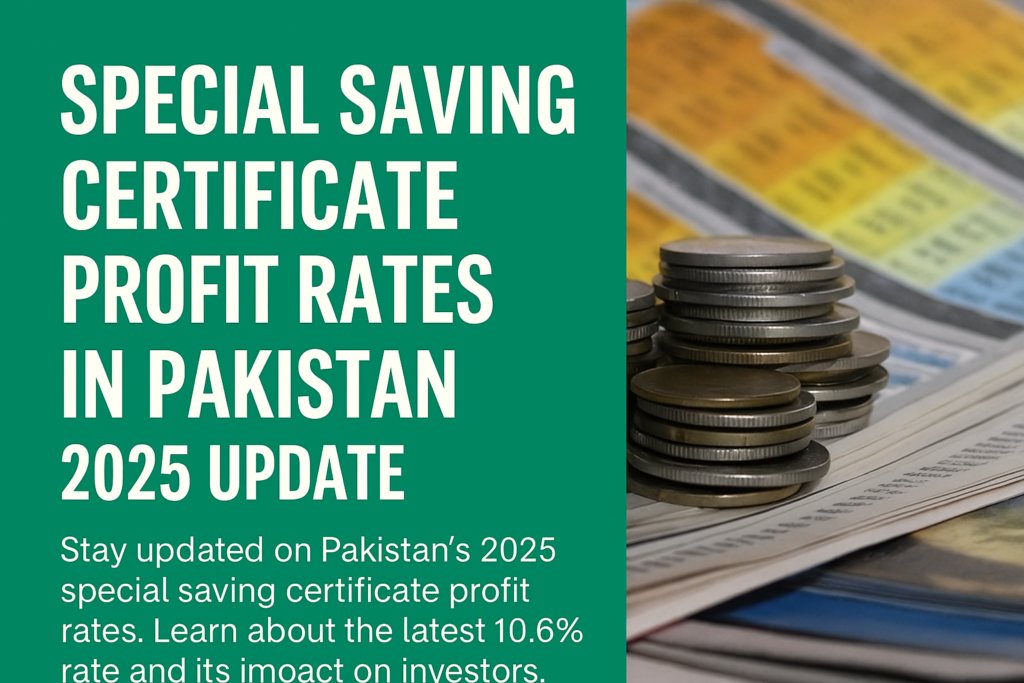Introduction – Special Saving Certificate Profit Rates:
Pakistan’s National Savings plans have long been a mainstay of low-risk investing, especially for middle-class families, retirees, and anybody looking for steady income. The Special Saving Certificate (SSC) is a standout among these products since it provides flexibility and steady returns every six months. The government has once again changed the profit rates for a number of savings plans as 2025 approaches, with special saving certificate profit rates being a significant change for investors.
This article explores the details of the 2025 profit rate revisions, the reasons behind the adjustments, their implications for savers, and what investors in Pakistan should expect in the coming months.
What Are Special Saving Certificates (SSCs)?
The Central Directorate of National Savings (CDNS), a division of the Ministry of Finance, offers medium-term investment products called Special Saving Certificates. They were created to promote household savings and give people who want steady earnings free from the volatility of the stock or commodities markets a secure, government-backed alternative.
- Duration of Maturity: 3 years
- Profit Payments: Semi-annual (every six months) profit payments
- Investment Denominations: Investment denominations are accessible to a broad spectrum of investors due to their availability in quantities ranging from Rs. 500 and above.
- Target Market: Families, retirees, and salaried persons seeking to generate consistent income while protecting investments.

To go through the product listings, buy in bulk, and get the best deal. Visit Zarea right now! The biggest business-to-business (B2B) commodities marketplace in Pakistan, it is establishing the benchmark for the country’s future commodity commerce and distribution.
Profit Rate Update 2025:
The government changed the profit rates for many National Savings plans, including SSCs, in June 2025. The modifications are a reflection of larger monetary adjustments made in reaction to measures to stabilise Pakistan’s banking sector and falling inflation.
- The special saving certificates profit rates have been lowered by 30 basis points (bps).
- The rate was formerly 10.9%, however it has now been amended to 10.6%.
- SSCs are now in line with other savings products that have had downward modifications, such Regular Income Certificates and Defence Savings Certificates.
Thousands of investors who depend on SSCs for semi-annual profit income are immediately impacted by the decrease, despite its seemingly small size.
Why Were Profit Rates Reduced?
Several factors contributed to the downward revision of special saving certificate profit rates in 2025:
Trends of Declining Inflation
Following a spike in 2022–2023, Pakistan’s inflation rate has been declining recently. The government determined that it was possible to lower savings program rates when consumer price pressures subsided.
Coordination of Monetary Policy
In an effort to boost economic activity, the State Bank of Pakistan (SBP) has been gradually reducing interest rates. Generally, changes in monetary policy are reflected in changes in national savings profit rates.
Attempts at Fiscal Consolidation
While lowering its reliance on costly domestic borrowing, the government is nonetheless managing its debt commitments. It seeks to strike a balance between sustainable fiscal management and investor returns by reducing profit rates.
Global Economic Factors
Declines in global interest rates, particularly in developed economies, also influenced Pakistan’s decision to recalibrate savings returns.
Comparison with Other National Savings Schemes:
The SSC revision is part of a broader restructuring of profit rates across National Savings products:
- Behbood Savings Certificates (BSCs): Reduced by 24bps to 13.2%
- Pensioners’ Benefit Accounts: Also cut by 24bps to 13.2%
- Regular Income Certificates: Reduced by 36bps to 11.16%
- Defence Savings Certificates: Slight reduction of 15bps to 11.76%
- Sarwa Islamic Accounts: Saw the largest reduction of 59bps, now at 9.75%
This adjustment shows a uniform policy direction where both conventional and Islamic savings schemes were revised downward, though at varying magnitudes.
Implications for Investors:
The revision in special saving certificate profit rates carries several implications:
Lower Income for Households
Investors relying on SSCs for supplementary household income will now receive slightly less during their semi-annual profit payments. For example, on an investment of Rs. 100,000, the profit payout will decline proportionately to the 30bps reduction.
Shift Toward Higher-Yield Schemes
Some investors may consider moving funds to other savings products, such as Behbood Savings Certificates, which still offer relatively higher returns, especially for senior citizens.
Promotion of Diversification
Although these investment alternatives are riskier than government savings vehicles, the reduction could encourage investors to look into alternate possibilities like bonds, mutual funds, or real estate.
Investment Climate Stability
Positively, the downward revision points to better macroeconomic circumstances, particularly as inflation declines. This indicates increasing financial stability in Pakistan for long-term investment.
Special Saving Certificates and Pakistan’s Economic Landscape:
The SSCs are more than just savings products—they play a strategic role in Pakistan’s economy:
- Mobilization of Domestic Savings: By attracting household funds, SSCs reduce reliance on external borrowing.
- Support for Government Spending: SSCs raise money that is used to close budget deficits and also raise funds for development initiatives.
- Investor Confidence: The profit rates of regular adjustments continue to maintain transparency and reinforce investor trust that takes into account current economic conditions.
Meanwhile investors may see somewhat lower returns in 2025 as compared to previous years. Further, the adjustment is indicative of wider patterns in economic recovery that might eventually spur growth.
Challenges Facing the Savings Sector:
SSCs and other national savings plans in Pakistan confront a number of difficulties despite their significance:
- Inflation Erosion: If inflation increases once again, actual gains might be lost even with yields of 10% to 11%.
- Limited Financial Inclusion: The official savings system does not cover a sizable section of Pakistan’s population.
- Dependency on Borrowing: Policy decisions may occasionally be skewed by the government’s reliance on savings plans to finance debt.
- Global Volatility: Any abrupt changes in the price of commodities or energy on a worldwide scale may lead to additional modifications in profit margins.
Outlook for 2025 and Beyond:
In the future, three major elements will significantly determine how special savings certificate profit rates develop:
- Monetary Policy Direction: SSC profit rates may witness more negative adjustments if the SBP keeps lowering interest rates gradually.
- Trends in Inflation: While steady or falling inflation may limit returns, any spike might lead to upward adjustments.
- Investor Behaviour: Policymakers may be compelled to keep SSCs competitive if there is a notable movement in investor preferences towards alternative assets.
All things considered, the pattern suggests a careful balancing act between maintaining economic restraint and assisting savers.
Final Thoughts:
The dynamic interplay between Pakistan’s economic policies, inflation trends, and investor expectations is emphasised in the 2025 update to special saving certificate profit rates. The drop to 10.6% indicates reduced short-term returns, but it also points to a strengthening macroeconomic climate that may lead to long-term stability.
The SSCs continue to be a secure, government-backed choice for investors looking for steady, semi-annual income. Nonetheless, diversification into higher-yielding alternatives can be encouraged by the drop in returns.
The change emphasises how crucial it is to remain educated in the end. On the other hand, you periodically assess investment portfolios, and modify savings plans. These actions take place in order to respond to changing market conditions.


































